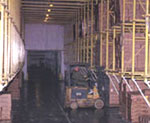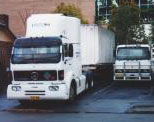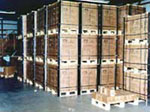Deliveries climb the IT bandwagon
By T Radhakrishna | 02 Dec 2002
 Bangalore:
In today''s depressed market, most companies are looking
to cut costs to shore up their bottomlines. An important
part of this effort is to make the supply chain more efficient
and drive down inventory.
Bangalore:
In today''s depressed market, most companies are looking
to cut costs to shore up their bottomlines. An important
part of this effort is to make the supply chain more efficient
and drive down inventory.
To deliver on this front, logistics and transportation companies are investing in technology that will allow them to manage information on consignment movement, billing, auditing and payment efficiently.
Not so long ago, most of the courier companies in India had only limited package-tracking systems in place. Today, courier companies are moving towards implementing complete workflow automation systems.
![]() "We
are using IT solutions for most of our activities. Without
IT, it is very difficulty to manage services," says
Meera Madhusudan, senior executive at Gati and CEO &
director of Gati Intellects Systems.
"We
are using IT solutions for most of our activities. Without
IT, it is very difficulty to manage services," says
Meera Madhusudan, senior executive at Gati and CEO &
director of Gati Intellects Systems.
"The future of the logistics business depends on total integration of various applications," concurs Dinesh AP, manager IT at Samrat Shipping & Transport Systems. He feels companies really need to invest in IT to create a more robust architecture.
From
supply chain to warehouse management
Most logistics companies have also realised that they
need to move beyond shipment tracking and integrate all
their activities like supply chain, sales force and warehouse
management.
Gati Cargo, for example, is implementing an enterprise resource planning (ERP) package from Oracle Finance to make its supply chain more manageable. It has tied up with Satyam Computers to deploy new technologies — Oracle CRM, Oracle Finance and related customised software at a cost of Rs 7 crore.
 The
company is also putting in place a collaborative warehouse
and transport management system. For pickup and delivery,
it uses a logistics management system solution designed
and developed by iPlanet.
The
company is also putting in place a collaborative warehouse
and transport management system. For pickup and delivery,
it uses a logistics management system solution designed
and developed by iPlanet.
Other companies are also moving in the same direction.
Safexpress has developed its own software solutions for booking applications. It has also tied up with NIIT for implementing an ERP package.
Many companies feel use of technology will help them optimise consignment movement and eliminate wasteful practices. They say use of IT brings better control over various operations. Gati expects a 30 per cent reduction in its operational costs after the completion of its IT deployment plans.
Integrating
vehicle movement
Apart from cutting costs, IT helps companies plan for
possible off-schedule deliveries. Now, it''s possible for
them to integrate vehicle movement to the planning process.
That''s exactly what logistics company Exel has done. It has a separate application — Managed Transportation Service (MTS) — to monitor vehicle movement. The MTS has an Oracle database linked to Manugistics'' planning tool, Networks Transport. A real-time vehicle tracking and execution tool — Isotrak — and supplementary management and reporting tools are interfaced to the host system.
 Delivery
service company DHL too has separate modules for shipment
tracking and customer service. For ground operations,
it has shipment control libraries that assimilate information
on consignment tracking at different stages.
Delivery
service company DHL too has separate modules for shipment
tracking and customer service. For ground operations,
it has shipment control libraries that assimilate information
on consignment tracking at different stages.
DHL uses scanners at various points of movement that scan the goods and send across details to the servers. DHL is looking at next-generation scanners that can be connected to the GSM network. Currently, the company relies on a distributed architecture of HP Unix with HP servers in metros. "It takes unnecessary manpower and technical investment to have a distributed architecture in different countries and different cities," explains Das.
| Warehousing made easy
With the use of IT, physical warehousing has become almost irrelevant. Courier companies are capitalising on this by forming alliances with e-business vendors for warehousing. DHL is in talks with a premier hardware vendor to provide warehousing facilities. Blue Dart is considering providing such facilities to select customers. "It is very important for online businesses to deliver within 24 hours of a purchase order and that is where our skills lie," says Das of DHL. Some companies, like SembCorp Logistics, already offer warehouse management as one of their services. Chennai-based SembCorp has a logistics centre with a multi-user warehouse facility. Separate terminals have been given to the clients, where they run their own logistics management modules. Offering total warehouse and inventory management solutions entails a paradigm shift with regard to the way logistics companies look at IT integration. Meera Madhusudan from Gati says logistics processes will have to be customised to optimise delivery lead times and cut distribution costs. However, for companies to be able to provide total logistics solutions, IT holds the key. |
Safexpress tracks the movement of its vehicles through kiosks fitted with automated sensors. It has tied up with Hyderabad-based Highway Automation for installing such kiosks in major petrol bunks every 50 km. The service is currently available in New Delhi, Hyderabad, Bangalore, which will be extended throughout the country.
Safexpress vehicles are fitted with trans-receivers. "Instead of tracking the consignments, we track the vehicle itself," says Harish Iyer, manager-customer services & systems, Safexpress. Whenever a vehicle passes through these highways, the kiosks pick up the signals and transmit them to the corporate office in New Delhi.
The nature of tracking is also dependent on the nature of business. Samrat Shipping, a sea freight provider, has a different style of operation. It manages its entire tracking through its electronic data interchanges, whereby the customer can only find details of shipments. Other means of point-to-point tracking are still not possible, says Samrat''s Dinesh.
Beneficial
side-effects
Predictably, the IT integration is helping the companies
in other areas.
DHL now has a Web Application for Sales Performance that processes information on sales call planning, feedback, reports analysis, customer interests and contact database of customers — records information of customers logging into DHL services and builds a database.
"Often, it so happens that there is a market for DHL but we are not aware of it. This software detects it and helps the sales group direct the services arm to open centres in those areas," explains Prabal Das, technical manager, DHL Worldwide Express.
Bringing
scattered information together
The logistics industry in India has a scattered structure.
Branches and franchisees do a large chunk of the business
process. The challenge is to integrate information generated
at all these points. For example, Blue Dart has connected
most of its offices and every office has a person responsible
for IT implementation.
Similarly, Safexpress has a system for two-way relay of information on booking and delivery done at various franchisees. It uses a FoxPro-based solution developed in-house for booking. Franchisees do the booking and deliver the goods to the hubs on a day-to-day basis. The booking data is fed into the system and sent to the regional office where data is sorted and sent to the branch offices. Accordingly, the branches pass the information to the franchisees.
Giving
customers better service
To leverage the advantages of this data integration, companies
are looking to give customers better service in various
areas
 For
example, companies are making it easier for customers
to track their packages, through either the Internet or
telephone. DHL customers can get an instant SMS message
on the status of their packages by dialling +44 7720 334455
and putting in the air bill number. The customer can also
track the consignment by logging on to track@dhl.com.
Blue Dart allows for both SMS and online tracking.
For
example, companies are making it easier for customers
to track their packages, through either the Internet or
telephone. DHL customers can get an instant SMS message
on the status of their packages by dialling +44 7720 334455
and putting in the air bill number. The customer can also
track the consignment by logging on to track@dhl.com.
Blue Dart allows for both SMS and online tracking.
Most companies believe that Net-based tracking is an ideal option. To provide this, the entire process of tracking goods has to be automated, from booking to delivery.
Distributed
database vs unified
While some companies pitch for a distributed database
system, others believe in a unified database system to
contain costs.
Bluedart puts all its points of tracking into a centralised database. The company''s shipments are tracked at 17 points across the country. "We are developing a system wherein we have a central database in our head office in Mumbai and operate centrally," says Malcolm Monteiro, senior VP-sales & systems of Bluedart Express.
Bluedart has a distributed database structure on Oracle 8i and Sun Solaris in all the metro cities. These databases are connected with its networks across India — the company today has information of all 11,900 locations in its database. This structure has helped the company generate information on the delivery status with 97 per cent accuracy, says Monteiro.
Customised
applications the trend
 The
trend is toward implementing customised applications,
with off-the-shelf applications being rare. Most logistics
companies outsource their applications for their back-end
and front-end usage. However, they prefer to have their
own development teams to execute their high-security application
modules.
The
trend is toward implementing customised applications,
with off-the-shelf applications being rare. Most logistics
companies outsource their applications for their back-end
and front-end usage. However, they prefer to have their
own development teams to execute their high-security application
modules.
When DHL decided to get into logistics management, the idea was to create a secure and safe logistic system. Although DFL''s parent''s company AFL is into logistic packages, DHL develops its own packages at its APAC development centre in Kuala Lumpur.
Blue Dart too does its customisation and maintenance in-house. However, it has partners like Netcraft for Web-based applications, Wipro for Oracle and Sun integration and Microland for security. Safexpress also has an in-house software solution for its booking applications.
Although
IT will remain an integral part of the infrastructure
of logistics companies, CIOs still face the task of convincing
top management about the utility and cost-effectiveness
of the software and hardware. At Blue Dart, a steering
committee briefs employees on a particular technology
every month to bring in awareness. However, this is still
a rare example. This biggest challenge for CIOs in logistics
companies now might be raising IT awareness among their
own colleagues.
Featured articles

Lighter than air, yet very, very powerful
By Kiron Kasbekar | 03 Jan 2024
In March 2013 Chinese scientists pulled off a remarkable feat. They created the world’s lightest aerogel. Tipping the scales at a mere 0.16 milligrams per cubic centimeter – that’s a sixth of the weight of air!

COP28 explained: A closer look at COP28's climate change solutions
By Aniket Gupta | 27 Dec 2023
The 28th United Nations Climate Change Conference, also known as COP28, took place from 30th November 2023, to 13th December 2023, at Expo City in Dubai, United Arab Emirates.

What is a Ponzi scheme?
By Aniket Gupta | 06 Dec 2023
Ponzi schemes have long captivated the public imagination, drawing unsuspecting investors into a web of illusion and deception.

The Rise and Rise of HDFC Bank
03 Jul 2023
HDFC, which surged ahead of global majors like HSBC Holdings Plc and Citigroup Inc and left Indian peers like State Bank of India and ICICI Bank in market capitalisation, now ranks fourth largest among the world’s most valuable banks, after JPMorgan Chase & Co, Industrial and Commercial Bank of China Ltd and Bank of America Corp

India’s Millet Revolution To Enrich Global Food Basket
02 Apr 2023
Millets, a healthier and cheaper substitute to wheat and rice, are indigenous to many parts of the world, especially in the semiarid tropics of Asia and Africa, and offers a big scope for expanding production and consumption in the foodgrain deficient African continent

Market predator Hindenburg preys on Adani stock
06 Mar 2023
Almost a month after the damning report of short-seller Hindenburg Research on the Adani Group that claimed that the seven stocks within the group were about 85 per cent overvalued, one of the group's stocks, Adani Total Gas, closed at Rs835 on the BSE, down nearly 79 per cent from its 24 January level, almost close to reaching that valuation
Business History Videos

History of hovercraft Part 3...
By Kiron Kasbekar | Presenter: Kiron Kasbekar

History of hovercraft Part 2...
By Kiron Kasbekar | Presenter: Kiron Kasbekar

History of Hovercraft Part 1...
By Kiron Kasbekar | Presenter: Kiron Kasbekar




.jpg)






.jpg)









